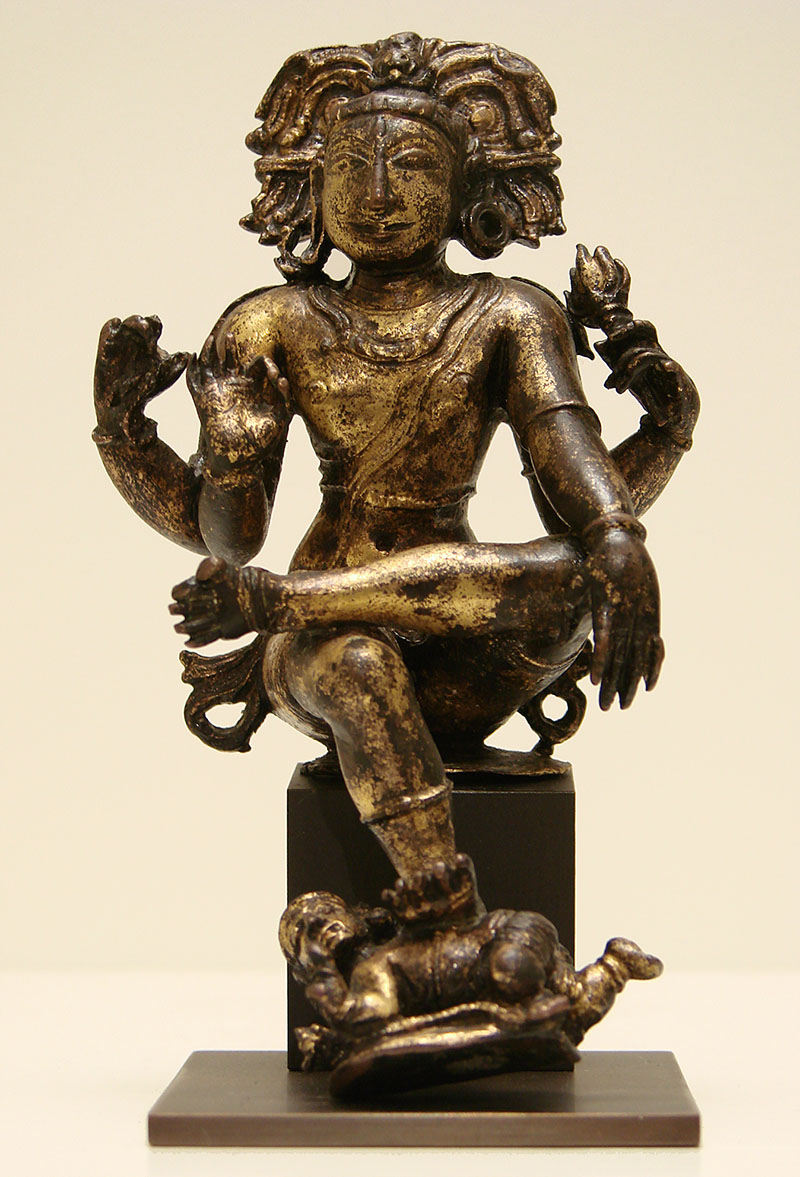A benevolent manifestation of the Hindu god Shiva, Dakshinamurti is believed to be the supreme teacher of the shastras (scriptures), yoga and music. Dakshinamurti figures are typically situated in a niche on the southern wall of a temple shrine.
Scholars have argued that Dakshinamurti was initially a manifestation of Shiva associated with the Pashupatas. The deity was believed to emanate from the right side of Shiva Mahadeva, and was propitiated for sacred knowledge. Textual references to this Dakshinamurti can be found in early mediaeval texts such as the Dakshinamurti Upanishad — part of the corpus of Shaivite Upanishads — as well as in the Skanda Purana of the seventh century. By the tenth century, worship of the deity became more broadly associated with temple-based Shaivism, and an iconography was developed interpreting the “dakshina” in his title as meaning “south”; this “south-facing” deity retained his original role as a dispenser of sacred knowledge.
Scholars have identified four main types of dakshinamurtis, based on the four types of teaching the figure is associated with. Of these, the Vyakhyana Dakshinamurti is most frequently represented in temple architecture. The deity is represented near a banyan tree, seated on a seat covered with tiger skin in the virasana pose, where the right leg hangs and the left leg rests on the right. The figure is represented with four arms, the front right held in the gyana mudra and the front left in varada or danda mudra. The back right hand holds an akshamala (string of beads) and the back left has either agni (fire) or a snake. The hair of the figure is matted, with a mukuta (headdress) decorated with flowers. The centre of the mukuta may feature the face of the goddess Ganga. The deity is shown with one foot on top of an apasmara purusha (dwarf). Another type, the Gyana Dakshinamurti, is represented similarly, with the difference being in the back left hand, which holds an utpala flower.
The Yoga Dakshinamurti is represented in three ways. The first kind involves the legs crossed in a svastikasana, with the front right hand held in the yoga mudra near the chest, and the front right hand resting on the lap. The back right and left hands hold an akshamala and a lotus flower respectively. In the second kind of representation, the figure is depicted bent in the utkatasana posture, with the body and left leg covered by a yoga patta (a cloth tied over the legs during meditation). The arms are depicted similarly, with the front left arm kept stretched across. The third type of Yoga Dakshinamurti is represented with bent legs kept in place with a yoga patta, with his two front arms stretched and resting on the knees. The back right and left hands hold an akshamala and kamandalu (water pot) respectively. The hair of all these depictions are in a jatamandala, adorned with a snake and crescent moon.
The last major type is the Vinadhara Dakshinamurti, represented with the vina (musical instrument) held in two of his arms. Dakshinamurti figures may also be accompanied by munis (sages), siddhas (ascetics), bhutas and vidyadharas, along with animals and natural depictions apart from the banyan tree.
Some of the earliest known sculptural images of Dakshinamurti are found in the Virattaneshvara temple at Tiruttani, dating to the late ninth century CE. Scholars have opined that the deity increased in popularity by the tenth century CE, as seen in Dakshinamurtis from the Tirupullamangai temple and the Vasishteswarar Karanthai temple in present-day Tamil Nadu. Dakshinamurti came to occupy an important position in the southern wall niches of temple architecture from this period onwards, and was also occasionally represented in Chola bronze sculpture.
Sculptural niches containing Dakshinamurti continued to be popular in temples built during the late mediaeval period, under the Nayaka rulers.







